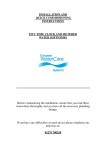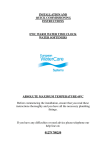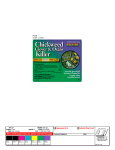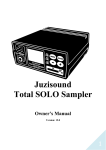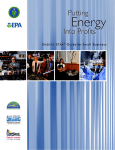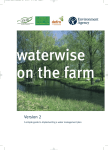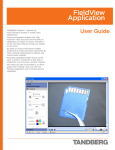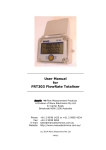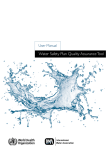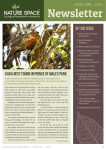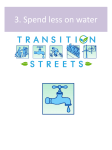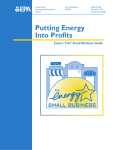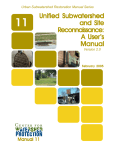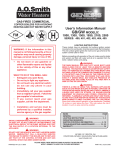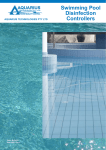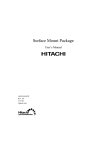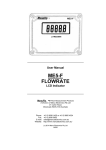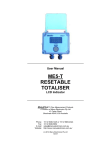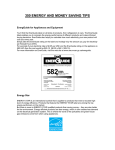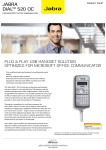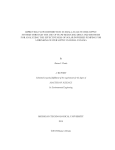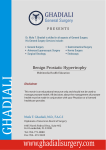Download Be Waterwise for businesses and organisations
Transcript
Bewaterwise For businesses and organisations Wa terca re S er v i ces L i m i ted B e w a terw ise For Bu s ine s s e s an d O rgan is atio n s Water and wastewater in Auckland If your organisation is in Auckland, Watercare is your water and wastewater services provider1. Each day, Watercare supplies around 326 million litres of drinking water to Auckland people and businesses, and treats wastewater to a high standard. The water is drawn from around 30 sources, treated and delivered via a vast network of pipes and reservoirs. Watercare is committed to promoting and encouraging water efficiency in Auckland and this commitment is now part of the Auckland Plan. The target is to reduce gross per capita consumption2 by 15% compared with the 2004 levels by 2025. Efficient water use is critical to defer the need for new water sources and additional water and wastewater treatment infrastructure. To achieve this, Watercare has a programme of work underway, detailed in the 2013-2016 Auckland Regional Water Demand Management Plan, available at www.watercare.co.nz Be waterwise for businesses is an initiative by Watercare to help Auckland organisations understand their water use and implement improvements in their processes to become more water-efficient. If you wish to know more about the programme, Watercare’s contact information is available on the back cover. 1. Except for Papakura, whose retail network is not operated by Watercare 2. Gross per capita consumption is the total amount of water used, including domestic, non‑domestic use and leaks divided by the population connected to the Watercare network Lower Nihotupu Dam in the Waitakere Ranges Page 2 Wa terca re S er v i ces L i m i ted B e w a terw ise For Bu s ine s s e s an d O rgan is atio n s Contents Introduction4 Why be waterwise? The waterwise journey 1. Get started6 •The importance of robust leak management •Get management engaged •Identify a programme coordinator •Get input from key staff members 2. Gather information10 •Record your overall water use •Understand water use per process 3. Assess your organisation’s water efficiency 16 •Create your water balance •Identify areas for improvement •Set measures and targets for water efficiency 4. Implement your water efficiency programme 20 •Manage leaks •Select water-efficient appliances •Waterwise practices for offices, production lines and outdoor spaces •Engage your staff •Success stories Wa te rcare Servi ces Li mi ted B e w aterwis e Index Fo r Businesse s a nd Org a nisa t io ns 31 Page 3 WH Y B E WAT E RW IS E ? Why be waterwise? Less pressure on water resources NEW ZEALAND NOT IMMUNE TO DRY SPELLS Waterwise business resilient when drought strikes Less pressure on treatment plants Volumetric charging of wastewater BRAND ENHANCEMENT Across small, medium or large organisations NO SIGNIFICANT INVESTMENT REQUIRED Better for company image Volumetric charging of water Water efficiency = lower wastewater costs Water efficiency = Business efficiency 1 Reduced operational costs Water efficiency = lower water costs PAY FOR WHAT YOU USE REDUCING YOUR ENVIRONMENTAL IMPACT WATER EFFICIENCY LEADS TO LOWER ENERGY COSTS CLIMATE CHANGE Water is finite LOWER CARBON FOOTPRINT Water is essential to life. Auckland is fortunate to benefit from regular rainfall most of the year. As a result, the availability of water for consumption, recreational and industrial purposes is often taken for granted. However, with the forecast growth in population and commercial activity, it is critical for Auckland to become more water-efficient. There are many benefits to becoming a water-efficient organisation. Unitec reduces water costs by a third Thanks to a group of key staff members getting together and the students running water efficiency audits, Unitec’s water and wastewater costs are $160,000 lower than what they were three years ago. (Read the whole story on watercare.co.nz) Page 4 Wa terca re S er v i ces L i m i ted B e w a terw ise For Bu s ine s s e s an d O rgan is atio n s WHY BE WATERWISE? Your waterwise journey Watercare recommends a staged approach to implement water efficiency in your organisation. This booklet will take you through each of these stages. If you are a small office-based company, this could be fairly simple and easy to complete. For a large manufacturing business, each stage may be more complex and require external help. Here is your waterwise journey at a glance: GET STARTED 1 GATHER INFORMATION 2 3 4 ASSESS YOUR ORGANISATION’S WATER EFFICIENCY IMPLEMENT YOUR WATER EFFICIENCY PROGRAMME 1 The importance of leak management 1 Record your overall water use 1 Create your water balance 1 Manage leaks 2 Get management engaged 2 Understand water use per process 2 Identify areas for improvement 2 Select water-efficient appliances 3 Identify a programme coordinator 3 Set measures and targets for water efficiency 3 Waterwise practices for offices, production lines and outdoor spaces 4 Get input from key staff members 4 Engage your staff 5 Success stories More details on page 6 More details on page 10 More details on page 16 More details on page 20 If you have any questions or need to discuss the stages in more detail, please contact Watercare. Wa te rcare Servi ces Li mi ted B e w aterwis e Fo r Businesse s a nd Org a nisa t io ns Page 5 Getting started Although water efficiency is a proven way to save money and resources in the long term, the programme will initially require some time from staff members. The most common waterwise initiatives, e.g. replacing a leaking pipe, could also involve an investment. As a result, it is important to set up a comprehensive framework before embarking on the implementation. 1 GET STARTED Page 6 1 The importance of leak management 2 Get management engaged 3 Identify a programme coordinator 4 Get input from key staff members Wa terca re S er v i ces L i m i ted B e w a terw ise For Bu s ine s s e s an d O rgan is atio n s G ETTING STARTED 1 The importance of robust leak management The next few pages will help you structure your approach to achieving water efficiency. But before you start, there is one crucial initiative you need to undertake as soon as you can. It is very important that you regularly check your pipes for leaks. Most of the time, leaks are hard to detect visually. It is rare to be able to see cracks in a pipe or notice a greener patch of grass in the lawn. Leaking water tends to flow underground unnoticed and professional leak detection services can help to isolate where it is happening. When they go undetected for a long time, leaks end up constituting a significant share of what you consider your ‘normal’ water use. Unless you have done a proper leak test, you cannot be certain that there is no water loss through leaks on your property. A hole as small as one millimetre can generate a water loss of thousands of litres a month. If you are able to stop using water for a few hours and access your water meter easily at your site, you could perform a simple leak test, described below, twice a year. Leak Test 1.Take a note of the reading on your meter. 2.Wait for at least two hours (or overnight, if possible) and do not use any water during this time. 3.Check the meter reading again. If the second reading is different from the first, you may have a leak. Watercare recommends using a registered plumber for any repairs. If you do not own the site and have no access to your water meter, see ‘What to ask your landlord?’ on page 12. How an old leak could make up half of your water use NZ Bakels manufactures and distributes a wide range of bakery ingredients. This requires significant amounts of water. Food processing companies are typically amongst the largest users of water in Auckland. When they spotted a ten percent spike in their water use, NZ Bakels hired a specialised service to detect and repair the leak. Instead of just fixing the leak individually, the company decided to replace a whole section of the old underground watermain. They immediately saw a 50 percent reduction in their water consumption. “We have now learnt not to assume that our water consumption is the ‘norm’”says Brad Taylor, Operations Manager, NZ Bakels (Read the whole story on watercare.co.nz) Wa te rcare Servi ces Li mi ted B e w aterwis e Fo r Businesse s a nd Org a nisa t io ns Page 7 GE TTI N G S TA RT E D 2 Get management engaged To create a successful, recognised and viable water efficiency programme in the long run, you must have the endorsement and support of the managers in your organisation. Make sure that your management has a realistic understanding of the potential costs and benefits involved before promoting to the wider company and committing money for expenses. Management buy-in increases employee engagement in the programme. It also facilitates the implementation of the suggested waterwise actions. A vision statement from your owner/manager/managing director or chief executive at the launch of the waterwise programme would help promote it to the wider company. Managers should also lead by example. Making them aware of the benefits of water efficiency and asking them to champion the initiative and communicate to their teams will foster greater staff involvement. 3 Identify a programme coordinator Water efficiency programmes are most effective when a staff member has been assigned the responsibility to manage them. It does not need to be a specific role or a formal position. It can form part of an existing role such as sustainability advisor or facilities manager. Responsibilities of this role include: •Leading your organisation’s waterwise programme •Gathering information about the organisation’s water use •Monitoring water and wastewater bills •Building a water use profile for the organisation •Assessing current efficiency and identifying areas for improvement •Determining targets for water efficiency and creating an action plan •Keeping staff informed and engaged •Assessing and recommending new initiatives •Coordinating the implementation of waterwise initiatives •Reporting to management on water efficiency This booklet describes how to deliver the above tasks. Page 8 Wa terca re S er v i ces L i m i ted B e w a terw ise For Bu s ine s s e s an d O rgan is atio n s G ETTING STARTED 4 Get input from key staff members The coordinator of the water efficiency programme will need significant input from other staff members or business units in the organisation. In medium to large organisations, these could include: •Facilities, for information on leak management, inventory of appliances, maintenance cycles and equipment models/features •Operations, for information on water use in processes and improvements to production lines •Sustainability, for integration in the company’s environmental performance and coordination with energy efficiency or waste reduction programmes •Communications, for promoting water efficiency initiatives and increasing staff engagement •Finance, for information on water and wastewater costs In smaller organisations the owner or manager will oversee all of the above functions and participate in, if not lead the water efficiency programme. It is useful to think about what roles should be part of the group. It is also worthwhile to approach employees who are passionate about using water wisely and ask them to champion these initiatives. Form a project group with relevant and engaged people and meet regularly to drive the waterwise programme. Consider using a water management tool to support your waterwise programme. These tools help you start the conversation with your key project group, ask the right questions and prioritise the organisation’s efforts. Contact Watercare for more information. Wa te rcare Servi ces Li mi ted B e w aterwis e Fo r Businesse s a nd Org a nisa t io ns Page 9 2 Gathering Information You cannot manage what you do not measure. A crucial step in your waterwise programme is to make sure you collect information on a regular basis. Two types of data need collecting: •The overall water and wastewater volumes and costs for your company are available on the monthly invoice from Watercare. You could capture this in a spreadsheet with bar graphs and update it monthly. •The breakdown of water use in your site (e.g. process water use vs. outdoor or bathrooms’ water use) will require a water efficiency audit, which is explained later in this section. This can be done once a year. GATHER INFORMATION Page 10 1 Record your overall water use 2 Understand water use per process Wa terca re S er v i ces L i m i ted B e w a terw ise For Bu s ine s s e s an d O rgan is atio n s G ATHERING INFORMATION 1 Record your overall water use Capturing the data from your invoice will enable you to review, on an ongoing basis, how your water efficiency programme is tracking. The monthly invoice from Watercare includes a graph of the water use in the previous 12 months and average daily usage of the most recent month, like the example below: Monthly water use profile Average daily usage in Mar 4064 L Consumption history A = Actual read E = Estimated read 50,000 45,000 LITRES PER DAY 40,000 35,000 30,000 25,000 20,000 15,000 10,000 5,000 0 Mar 2014 A Apr 2014 E May 2014 A Jun 2014 E Jul 2014 A Aug 2014 E Sep 2014 A Oct 2014 E Nov 2014 A Dec 2014 E Jan 2015 A Feb 2015 E Mar 2015 A The graph can help you build a profile of how much water you are using over time. This example highlights that the consumption has been steadily decreasing over nine months at the site, with a strong decrease in the last month. This could be due to the implementation of water efficiency initiatives or reduced activity in March and April. Capturing the usage and costs is key for ensuring that your water use is at the expected level, tracking your organisation’s progress, spotting spikes in use and determining water efficiency targets. For more information on how to read your invoice, see https://www.watercare.co.nz/ SiteCollectionDocuments/AllPDFS/Guide%20to%20reading%20your%20nondomestic%20bill.pdf What to do if you have multiple meters and accounts An efficient way to capture water usage on your sites and track usage pattern is to build a water and wastewater consumption spreadsheet. If you have multiple meters or accounts and would like a simple way to consolidate the information, Watercare can help by providing you a consumption report, like the example on the next page. For each of your Watercare accounts, the report displays the volumetric water usage and charges, the volumetric wastewater charge and the fixed wastewater charge. The frequency could be monthly, quarterly or yearly, depending on your needs. Please contact Watercare if you would like to have a free water consumption report provided to your organisation. Wa te rcare Servi ces Li mi ted B e w aterwis e Fo r Businesse s a nd Org a nisa t io ns Page 11 GATH E R I N G I N F O RM AT IO N Watercare consumption report January - February 2015 summary KEY: This section displays your water usage and associated costs per month and per site This section displays your estimated volumetric wastewater generation and associated costs per month and per site This section displays your fixed wastewater charge per month and per site What to do if you do not receive monthly invoices If you do not receive these invoices, it may well be that it goes straight to your accounting department. See whether you could get a copy from them or get online access to your accounts on www.watercare.co.nz It may also be that your landlord/property manager receives all invoices and your involvement has only been to the extent of paying the required amount. It is important for you to have access to usage data if you want to implement a water efficiency programme. What to ask your landlord? There are different types of tenancies: 1. You are the sole occupier of your landlord’s property In this case, it would mean that the Watercare invoice your landlord receives solely applies to your activities. If you want to get access to the water use data, you could: • Ask your landlord to share access to their Watercare online account with you (Watercare does not need to be informed) or to forward the invoices to you. • Ask your landlord to authorise Watercare to discuss the account information with you. 2. The property is occupied by several tenants (e.g. a multi-storey office building) This is more complex, since your landlord probably does not get usage information for each of the tenants. One way to get usage data is for the landlord to install a sub-meter at each of the tenants’ location in the property. The landlord can read the sub-meters and split the monthly invoice amongst tenants based on actual individual usage. Some landlords have implemented this, so check with your landlord if they would be willing to install it. The installation of sub-meters can be done by a plumber and will incur a cost for your landlord. Page 12 Wa terca re S er v i ces L i m i ted B e w a terw ise For Bu s ine s s e s an d O rgan is atio n s G ATHERING INFORMATION 2 Understand water use per process Once you have captured your water costs and usage data, it is time to identify the quantities and uses of water per process or facility on the site. This can be very quick for an officebased organisation, where the plumbing layout will be simple and the scope of the audit will be limited to water use in kitchens, offices and bathrooms. An industrial organisation will need to take more time to include and understand all processes that consume water. The methodology is the same for all organisations, regardless of size. Running a water efficiency audit 1. Prepare •Identify key staff members familiar with operations and water use on site •Get access to the plumbing layout (through the staff members in charge of the facilities or your landlord) •Determine if there is an alternate water supply (e.g. rainwater tank, bore or recycled water) •Establish the number of employees onsite and the site’s operating hours •Create a preliminary list of water using equipment and processes (including outdoor spaces) •Check if there have been previous water efficiency audits 2. Survey your site with the identified key staff members •Verify the plumbing layout and all water using equipment and processes •Identify obvious leaks •Quantify the water used by each appliance. For taps, showers and hose this can be done by measuring the flow rate (see page 14). For other types of equipment, this information could be included in the user manual. •Assess the time or frequency of the equipment used. This could involve surveying the facilities, asking staff members or reading user guides. •Capture the results in a spreadsheet, as below: Water audit spreadsheet Date: Physical address of the site: Name of recorder: Appliance / Facility Number of times used per day Volume each use (litres) Example: Dishwasher 2 30 Volume (litres) per day (Number of times used x volume = volume per day) 60 Supplier’s information Supplier’s information Example: Toilet 36 11 396 Example: Hose 1 1090 1090 Total Method of measurement Flow rate 1546 Source: Target Sustainability Programme, Christchurch City Council Wa te rcare Servi ces Li mi ted B e w aterwis e Fo r Businesse s a nd Org a nisa t io ns Page 13 GATH E R I N G I N F O RM AT IO N How to measure flow rate The flow rate is the amount of water flowing from your hose, showers and taps per minute. Flow rate is a key factor of your plumbing system. If the flow rate is really high, it could result in excessive water use. If you do not wish to use a plumber to measure this, you can do this in-house. You will need a bucket or large jug with measurements and a stopwatch. 1. Turn the tap to its normal setting and let it flow into the bucket for 10 seconds 2. Measure the amount of water in the bucket 3. Multiply it by six. This is the flow rate. Flow rate (litres per minute) = Amount measured for ten seconds x six 4. Record the flow rate in the water audit spread sheet (see page 13) 3. Calculate the full cost of the water the site is using •Identify the appliance(s) that use the largest amount of water •Identify other costs involved in using water (e.g. if water needs heating, treating, pumping or incurred wastewater costs) The table below helps you do a high-level assessment of the costs. Water and wastewater costs in Auckland in 2015 Volumetric cost of 1 kilolitre of water supplied by Watercare $1.375 Volumetric cost of 1 kilolitre of water treated by Watercare From $2.76 to $4.38 Potential energy involved with water use in your facilities (assuming industrial rate of $0.15 per kWh of electricity) Process Indicative energy required Indicative electricity cost Pumping 1 kilolitre of water 0.3 kWh $0.05 Heating 1 kilolitre of water from 15°C to 60°C 52 kWh $8 780 kWh $117 Steaming (raising 1 kilolitre of water from 1 bar(a) and 15°C to wet steam at 11 bar(a) and 184°C) If you would like a full energy audit of existing and potential equipment, tools and resources are available with the Energy Efficiency and Conservation Authority (EECA) at www.eeca.govt.nz. Page 14 Wa terca re S er v i ces L i m i ted B e w a terw ise For Bu s ine s s e s an d O rgan is atio n s G ATHERING INFORMATION What to do if you need a more detailed analysis Data loggers You may want to use more accurate tools to establish the water use profile on a typical day. This can be done with a data logger temporarily installed on your water meter to record water going through the meter every five minutes. The data logger will enable you to understand whether the water use occurs at the times and quantities expected, which will help spot the processes needing to be reviewed. For example, a spike in the morning every day of the week could be due to irrigation of lawns, prompting you to consider if they need to be watered daily even during winter months. Another benefit of the logger is to help you establish the nightline, which is the water used during the lowest demand on the site (for example between 3am and 5am). If the business does not operate 24/7, it can be assumed that most of the water consumed at that time is leakage. Some businesses have chosen to have data loggers on their meters permanently and even have alarms when the nightline becomes too high. Sub-metering and check metering If you have a complex site with varied processes, you could choose to measure the water use per process. This can be done by temporarily attaching an ultrasonic device to the top of your pipes which will measure the flow of water going through that pipe. This is called check metering and can be provided by the same companies that provide data loggers. Or you could choose to permanently install meters on your site, which is called sub-metering. This will enable you to review water use per process in an ongoing and accurate way. Wa te rcare Servi ces Li mi ted B e w aterwis e Fo r Businesse s a nd Org a nisa t io ns Page 15 Assess your organisation’s water efficiency 3 The path to becoming a water-efficient organisation is one of continuous improvement; no matter what your water use audits reveal about your water efficiency, you should not be discouraged from pursuing these initiatives. Whether you have a long way to go to become water-efficient or you already have some measures in place, there is always more your organisation can do. ASSESS YOUR ORGANISATION’S WATER EFFICIENCY Page 16 1 Create your water balance 2 Identify areas for improvement 3 Set measures and targets for water efficiency Wa terca re S er v i ces L i m i ted B e w a terw ise For Bu s ine s s e s an d O rgan is atio n s ASSESS YOUR ORGANIS ATION’S WATER EFFICIENCY 1 Create your water balance With the information you have collected through the water efficiency audit, you are in a position to know how much water is used per process in your organisation. This can be summarised in a ‘water balance’. An example is included below: WATER SUPPLY FROM WATERCARE ALTERNATE WATER SUPPLY (e.g. rainwater, bore) 85 kilolitres (kL) last month 0kL (No alternate supply) 75kL 5kL Key business activity Staff amenities •Water added to the product •Process use •Water used by customers on site •Equipment washing 6kL 65kL 1kL 3kL 2kL Outdoor water use •Toilets, basins and showers 4kL •Dishwashers, food preparation and sinks 1kL •Irrigation •Cleaning and water blasting Support processes 2kL •Pools 1kL •Cooling towers •Cleaning of 1kL facilities •Water features •Exceptional water use 3kL 1kL Leaks? OkL KEY: Wastewater and tradewaste Evaporation and steam Water in product Water in garden Input Output Losses abc Outcome of the audit You can use your water balance to: •Explain water use on your site to staff and management •Highlight where the largest amounts of water are used in your organisation, which can help identify where you should focus your water saving efforts •Determine if there are any leaks; in the example above, the amount of water measured by the meter equals the sum of the water used by the processes, which means that there are no leaks. If you notice a significant gap between the water used in your processes and the water billed every month, you should definitely check for leaks. Wa te rcare Servi ces Li mi ted B e w aterwis e Fo r Businesse s a nd Org a nisa t io ns Page 17 A S S E S S Y OU R OR GA N I S ATI ON ’S WATE R E FFI C IE NCY 2 Identify areas for improvement Below are the key factors to keep in mind to help you move to the next step and build your action plan: Leak management – It cannot be stated enough – you must have a regular programme of checking for leaks. Waterless options – To maximise results, your review of water-efficient alternatives should consider waterless options first. Waterless options achieve the same outcome (e.g. cleaning the outdoor areas) with a process that does not require water (e.g. broom as opposed to water blaster). Sometimes, it is easier and more effective to consider waterless alternatives instead of trying to reduce the water used by the current process. Pressure – What is the current pressure of your water? Consider getting a plumber to investigate whether pressure is higher than required; higher pressure can affect pipes and increase the risk of leakage. Flow rate – Compare each flow rate measured during the audit with the recommended rate in the next pages of this booklet. Market research – If your processes and machines are very specific to your industry, working with your staff and interviewing suppliers is the best way to understand all available options. Technology and behaviours – A successful water efficiency campaign targets both improved processes and improved behaviours. Make sure the waterwise initiatives you select include a good mix of process and people-related improvements. Page 18 Wa terca re S er v i ces L i m i ted B e w a terw ise For Bu s ine s s e s an d O rgan is atio n s ASSESS YOUR ORGANIS ATION’S WATER EFFICIENCY 3 Set measures and targets for water efficiency Establish a meaningful unit of measure It is useful to determine a unit of measure specific to your industry i.e. litres of water used per unit of production. This enables the company to assess water efficiency without being influenced by the variability of production volumes or the number of people on site. You can also compare this result between sites or with other organisations in the same industry. Examples of industry-specific units of measure include: • Offices: litres per square meter or litres per employee •Accommodations: litres per room or litres per patron •Manufacturing and food processing: kilolitres per tonne of product •Restaurants: litres per cover or litres per table •Laundries: litres per kilogramme of linen •Shopping centres: litres per square meter •Sports fields: kilolitres per hectare •Dairy farming: litres per litre of milk produced Overall water use and water efficiency per unit can be included in the organisation’s performance measures and be part of its daily, monthly or yearly reporting cycle. Water efficiency benchmarks Businesses are often looking for benchmarks to understand how well they are doing compared to their peers or competitors. Within an industry, each facility’s water use will vary depending on factors such as the age of the pipes, the number of non-employee visitors and the presence and size of cooling towers, cafeterias, and irrigated areas. As a result, if your company’s water use is lower than an established benchmark, it need not necessarily mean that your processes are as efficient as they could be. The following Australian websites display water efficiency benchmarks. Keep in mind that Australia has a drier climate than Auckland, which means that the same facilities (e.g. a green sports field) would require more water in Australia than in New Zealand. •The national benchmark project: http://www.nbweb.com.au/ •Search ‘Benchmarks for water use’ at http://www.sydneywater.com.au If you have several sites or facilities of the same type, the most useful benchmark is to see how they compare with each other and understand why they are different. Set an ambitious and achievable water efficiency target By this stage, you may have identified areas for improvement or at least have a sense of the savings that could be achieved. Even if there are still some unknowns, it is good to establish an ambitious but achievable goal at this stage of the project. Anecdotal experience shows that most businesses that engage in a waterwise campaign for the first time can realistically reduce their water use by at least 15%. Wa te rcare Servi ces Li mi ted B e w aterwis e Fo r Businesse s a nd Org a nisa t io ns Page 19 4 ASSESS YOUR ORGANISATION’S WATER EFFICIENCY Implement your water efficiency programme This section provides ways to reduce water use in your offices, outdoor spaces and production facilities. While the guide is intended to cover as many industries as possible, your employees and suppliers may be able to provide more specific and relevant advice. IMPLEMENT YOUR WATER EFFICIENCY PROGRAMME Page 20 1 Manage leaks 2 Select water efficient appliances 3 Waterwise practices for offices, production lines and outdoor spaces 4 Engage your staff 5 Success stories Wa terca re S er v i ces L i m i ted B e w a terw ise For Bu s ine s s e s an d O rgan is atio n s IMPL EMENT YOUR WATE R EFFICIENCY PROGRAM M E 1 Ongoing leak management Fixing old leaks, detecting new ones early and upgrading ageing pipes amount to around 40% of the water savings businesses achieve when implementing water efficiency measures. It is a significant initiative and you should prioritise this as one of the first things to undertake. To manage leaks on an ongoing basis, it is recommended that you: •Use your monthly water use profile to spot spikes in water use and identify leaks early (see page 11). •Include regular leak tests in your facilities management schedule (see how to do a leak test on page 7). •Replace worn seals on water pipes and repair leaking pipes, valves or taps •Replace whole sections of ageing pipes if they are prone to leakage 2 When replacing your appliances Water efficiency standards in appliances have been improving continuously over the past years. When you replace or upgrade your appliances, make sure you choose a waterefficient one. Washing machines, dishwashers, toilets, showers, taps and urinals [brand] [model] [rated load capacity] kg [X] The Ministry for the Environment’s Water Efficiency Labelling Scheme (WELS) applies to these products and makes it easy for you to determine how water-efficient they are. The more stars a label has, the more water-efficient the product is. The blue water rating label should be displayed in the store or on the catalogue alongside the appliance. See http://www.mfe.govt.nz/publications/wels-introduction for more information. using [stated wash] programme Other appliances For other appliances not covered by the WELS rating, it is worth asking your appliance suppliers about their water efficiency. The cost of the appliance’s daily water use could justify choosing a more expensive but also more water-efficient model. Wa te rcare Servi ces Li mi ted B e w aterwis e Fo r Businesse s a nd Org a nisa t io ns Page 21 I MP LE ME N T Y OU R WATE R E FFI C I E N C Y P RO G RA M M E 3 Waterwise practices for your offices, production lines and outdoor spaces CLEANING Cleaning production lines, car parks or storage areas with hoses running for a long period is a common practice. This cleaning method has been one of the main reasons why industries with low water needs end up having significant water bills. To make cleaning more water-efficient, you can: •Eliminate unnecessary cleaning. •Consider waterless methods such as: - safety air guns for cleaning process equipment (make sure safety glasses are used, and relevant health and safety procedures are in place) - brooms for sweeping - vacuum cleaners - air blowers. •Make your current method more efficient by: - fitting all hoses with trigger-operated guns so that they cannot be left on without supervision - installing high-pressure nozzles where possible to increase the pressure of the jet and reduce its water use. •Reuse process or cleaning water for the pre-wash of equipment or for cleaning the floors. BATHROOMS AND TOILETS Most toilets in Auckland use around seven litres per flush and older single flush toilets use 12 litres. The standard dual flush toilet now uses significantly less, with 4.5 litres for a full flush and three litres for a half flush. Taps and shower heads have also become more efficient. The flow rate can be decreased without losing the comfort factor. If installing new bathrooms: •Select low-flow showerheads. A flow rate of nine litres per minutes is considered to be water-efficient and will also ensure a comfortable shower. •Consider waterless urinals. •Make sure you check the WELS rating of your new toilets, taps and showers. See page 21. If reviewing your existing bathrooms: •Check for leaks. Small drips leaking from your water cistern can result in thousands of litres wasted. Put a few drops of food colouring in the cistern. If colouring ends up in the toilet bowl without flushing, you have a leak. Get it repaired. •Retrofit simple, inexpensive flow restrictors on your taps and shower heads if they produce more than nine litres per minute. These can be obtained from places such as plumbing stores or EcoMatters Environment Trust. See page 14 for information on calculating your flow rate and the back of this booklet for EcoMatters’ contact details. Page 22 Wa terca re S er v i ces L i m i ted B e w a terw ise For Bu s ine s s e s an d O rgan is atio n s IMPL EMENT YOUR WATE R EFFICIENCY PROGRAM M E •Check that your hot water system thermostat is not set too high. Adding cold water to cool very hot water wastes water and energy. The recommended temperature is 60°C. Ask an electrician or plumber to adjust it if needed. •If you have single flush toilets and do not want to replace them, you can make them more efficient by installing a gizmo. A gizmo is a simple weight that hangs inside the cistern tube and stops the flush when you take your finger off the button, so you control how long each flush lasts. These are also available from EcoMatters Environment Trust. KITCHENS Washing dishes •With modern dishwashers, there is no need to rinse the dishes first, though most people do this from habit. If the dishes are not clean after going through the cycle, you may need to clean or repair your dishwasher. •When hand-washing dishes, fill the sink rather than rinsing and washing the dishes under a running tap. •By installing simple, inexpensive tap aerators on your kitchen taps you can reduce the flow of water into the sink. •When replacing the dishwasher, compare the WELS rating of different models. Modern dishwashers use up to 60% less water than older models and are as efficient as hand washing. Dishwashers with five-star water ratings use as little as seven litres of water per wash. •If a conveyor system is used, check that water turns off when every load is finished. Cooking •If you have a sink waste disposal unit, be aware that it can increase your water consumption. You may want to consider composting food waste instead. The Kaipatiki Project provides free composting courses throughout Auckland, and commercial services are now available to collect and compost your food waste. Contact the Solid Waste team at Auckland Council. •Avoid thawing foods with running water. Alternatives include thawing in the fridge, in a microwave, or in the cooking process. •Avoid using running water to wash fruits and vegetables. Even if you are washing large amounts of food, wash it in a basin and then refill to rinse as necessary, and reuse the water if possible. Wa te rcare Servi ces Li mi ted B e w aterwis e Fo r Businesse s a nd Org a nisa t io ns Page 23 I MP LE ME N T Y OU R WATE R E FFI C I E N C Y P RO G RA M M E LAUNDRIES •Front loading washing machines typically use about 50% less water, 35% less detergent and 30% less energy than equivalent-sized top loading washing machines, making them the most cost effective option in the Consumer New Zealand assessments. Where large amounts of laundry are produced as a result of the main business activity - for example a hotel or commercial laundry, front loaders have great additional benefits. These include better wash quality (mechanical action compared to agitation), saving space (dryers can be fixed on the wall above front loaders) and reduced wear and tear on clothes and linen. •Choose the right temperature and program for the level of cleaning required. In hotels, barely used sheets and towels are washed in an extensive programme of hot water and chemicals. With proper sorting of the linen, most of this type of load could be washed with unheated water in a short cycle and less detergent. •Ensure equipment such as washing machines, boilers, pumps, chillers and water heaters are used according to actual loads, are shut down when not in use and properly maintained to prevent water loss due to leaks, steam or condensation. •Only use washing machines for full loads and make sure the machines are not undersized. Undersized machines result in staff having to take shortcuts to cope with the load. •Install a water reuse system to divert greywater for irrigating the garden or lawns. PRODUCTION LINE •Adjust flow rates to the minimum setting required. Using excessive amounts of water is a common practice due to the belief that it will improve hygiene on the production line. This wastes both water and chemicals. •Make sure sprays and jets are turned off when the production line is not in use. Switches, timers or motion sensors can help achieve this. •Install high pressure, water-efficient spray jets. •Install flow restrictors and regulators where appropriate. •Use pedals and timers to deliver water only when needed. •Use fogging nozzles instead of running taps and hoses when cooling products. •Ensure wash tanks and storage tanks do not overflow. •Replace old equipment with water-efficient alternatives. •Implement counter-current rinse systems. COOLING TOWERS AND PROCESS WATER COOLING • Regularly check for leaks in the cooling tower. • Use rainwater or process water to supplement fresh water for cooling towers. • Adjust valves and seals of the makeup supply to avoid overflows. • If cooling water cannot be re-circulated, reuse this water in other processes such as cleaning. • Use air-cooled rather than water-cooled processes (e.g. ice making machines). Take into account the energy requirements of such systems. Page 24 Wa terca re S er v i ces L i m i ted B e w a terw ise For Bu s ine s s e s an d O rgan is atio n s IMPL EMENT YOUR WATE R EFFICIENCY PROGRAM M E OUTDOOR WATER USE Implementing water efficiency measures for your outdoor spaces means you can reduce the volume of high-quality drinking water used on lawns, plants and pavements. Outdoor water use during summer puts a strain on water supplies when water resources are scarce. Landscaping choices The amount of water you will need to sustain your outdoor space through summer depends on your landscaping choices. Native species will require less water and maintenance than water-hungry exotic flowers. The art of landscaping a garden with low water needs is called xeriscaping. Lawns •Grow your grass a little longer in the summer. It will stay greener than a closemown lawn; it also strengthens the root system and shades the root zone, requiring less irrigation. •Some lawn grass mixtures can be allowed to dry out and go yellow in summer. They will recover in autumn. Avoid cutting them short before stopping irrigation. •Look for a drought-resistant lawn seed mix such as perennial ryegrass, fescues and Kentucky bluegrass when laying a new lawn. Irrigation Irrigation can use up a lot of water, with sprinklers being left on for longer than needed. Some sprinklers use as much water in an hour as a family of four Aucklanders uses in a day. There are some ways to improve your watering practices: •Automate your irrigation Automated irrigation systems including timers can be a way to make watering of outdoor spaces more water-efficient; it can be as simple as adding a timer to the tap connected to the sprinkler. •Use ‘smart’ sensors The frequency and duration of irrigation needs to be adjusted according to the weather conditions or soil moisture levels. Even if your system is already equipped with sensors, it is worth reviewing it. For instance, rain sensors switch off irrigation if it is raining. However, Auckland has a moist climate and the plants do not need to be watered every day even if it is not raining. A moisture sensor is a better option; it waits for the ground to be dry before triggering irrigation. Other sensors include climate variables and will adjust depending on rain or sunshine. •Install micro-irrigation where possible Micro irrigation systems or ‘drip’ irrigation systems apply water to the root zone of the plant at frequent intervals so that soil moisture levels are maintained at optimum levels. This reduces water wasted through evaporation and excessive watering. It is not appropriate for lawns but is the most water-efficient method for trees, shrubs and garden beds. Irrigation at Auckland Museum After installing a smart meter, the sustainability engineer could clearly see the times and amount of water being used throughout the day. It was discovered that early morning irrigation made up 30% of the total daily water use of the museum. After analysing this data, the engineering teams reviewed the operation of the irrigation systems. Rain sensors and soil moisture meters were installed to automatically switch off the irrigation systems during periods of wet weather. The system was also closely monitored throughout the winter months. By having this monitoring system and control regime in place, water consumption has dropped approximately 10–15%. Wa te rcare Servi ces Li mi ted B e w aterwis e Fo r Businesse s a nd Org a nisa t io ns Page 25 I MP LE ME N T Y OU R WATE R E FFI C I E N C Y P R O G RA M M E Pools •Install pool and spa covers. This reduces evaporation. •Examine the pool infrastructure regularly to detect leaks. •Check the water level in your pool regularly to be aware of any water loss. Water recycling •Identify processes where water is being discharged. This includes water from equipment cleaning, filtered backwash water, cooling and cleaning water, and water used for transport. •Identify areas for using the recycled water. These may include: - Cooling tower water - Industrial processes - Equipment cooling and cleaning - Toilet flushing. •Check to see where water treatment is necessary before recycling. Collecting rainwater Auckland benefits from regular rainfall most of the year. Roof-collected rainwater can supplement mains water supply for non-potable water uses, such as irrigation, toilet flushing, floor cleaning and cooling towers. Assess how much rainwater can be collected given your roof area, roof surface and rainfall levels. Compare this with your water usage and decide the size of the rain tank which best suits your needs. Contact Watercare for more details. Rainwater harvesting in residential properties is a relatively common practice in Auckland. Whilst there are many similarities between residential and non-residential rainwater systems, your organisation has a responsibility to protect the health of its employees. Before implementing rainwater collection, you should consider: •liabilities associated with the supply of water by an organisation •whether sensitive populations (e.g. children, patients) will be using rainwater •the best way to remove the risk of cross-connection between rainwater and drinking water pipes. You should also give particular attention to: •the quality of the catchment area •capture, filtration and storage systems •monitoring and maintenance of the rainwater system. Where a public water supply is available in Auckland, Auckland Council does not recommend collecting rainwater for potable water use such as in kitchens and bathrooms. However, you could get your project consented if you give sufficient guarantee about the quality of the water treatment process in your proposed rainwater harvesting system. Page 26 Wa terca re S er v i ces L i m i ted B e w a terw ise For Bu s ine s s e s an d O rgan is atio n s IMPL EMENT YOUR WATE R EFFICIENCY PROGRAM M E 4 Engage your staff Your organisation’s workforce has a huge influence on how water is used. Employees are also often the best to come up with ideas on how to be waterwise because they are familiar with how things work. Your waterwise programme will involve creating a culture of water efficiency. Find out how much your employees know about water A good place to start promoting water efficiency to employees is by finding out how much they know about water use at office and onsite, and what their water consumption behaviours are on a daily basis. This can be done through a quick, short survey; the results will highlight areas for change as well as useful feedback from people in the know. Ask for feedback Often, it is the details that make the difference. Ask your staff what processes would help them be waterwise – making it easy to turn off a device, rearranging a production line or kitchen. The team may also have no culture of water efficiency yet and as a result leaks are not reported and equipment is left on. Make sure your colleagues are aware of shutdown procedures and water efficiency measures. These should be included in staff inductions and also be displayed on the wall next to the equipment they refer to. Include waterwise messages in your facilities and internal communications. Communicate your objectives and achievements Once your water efficiency targets are set and your implementation plan is ready, communicate what you are aiming for. When you achieve your objectives, celebrate and help staff members relate to what has been accomplished. You could talk about volumes of water saved or dollars saved and explain how the benefits will be reinvested. Recognise good ideas Many companies have continuous improvement awards where employees get recognised for the improvements they suggest. This could include water efficiency too. Staff members need to be regularly reminded to contribute. You also need to define what the incentive or reward scheme will be and how you will follow up on ideas collected. Train Some behaviour changes or introduction of new equipment will require training. Moving to waterless or water-efficient cleaning for instance will require more than just telling your staff to use a different tool. Keep staff engagement going Embedding a water efficiency culture is an ongoing process. Make sure that you have scheduled regular briefings with staff and frequent reminders about objectives, achievements and how your colleagues can contribute. Encourage waterwise behaviours at home If you can inspire staff to use water wisely at home, they are very likely to repeat this behaviour at work. You will find more information on how to be waterwise at home in the Bewaterwise domestic booklet, available at www.watercare.co.nz. Watercare also offers a free water audit service for households who want to be more water-efficient. Feel free to promote this service to your staff. They can contact Watercare to sign up. Wa te rcare Servi ces Li mi ted B e w aterwis e Fo r Businesse s a nd Org a nisa t io ns Page 27 I MP LE ME N T Y OU R WATE R E FFI C I E N C Y P RO G RA M M E 5 Success stories The following examples are successful water efficiency initiatives led in Australia. Due to its geographical and climate constraints, Australia has done and documented significant work on water efficiency with businesses. These examples are all relevant for Auckland businesses as we have very similar processes and opportunities. Watercare will work towards documenting more Auckland-based success stories. Manufacturing Source: Water Services Association of Australia When named among the Victorian companies using large volumes of water and as a result required to undertake a water management action plan, a manufacturing company managed to reduce its water use to a third of what it was by: - Reusing cooling water from the manufacturing process - Water conservation signage to promote staff changes in attitudes and behaviours - Early detection of leaks to ensure prolonged leakage does not occur onsite - Retrofitting bathrooms with water-efficient appliances. (Read the whole story on www.wsaa.asn.au, page 27 of ‘Occasional paper 23 – Meeting Australia’s water challenges’) Beverage production Source: EPA South Australia In an Australian brewery, the lack of rigorous housekeeping and maintenance procedures caused filling apparatus and fill detectors to fall outside of calibration limits leading to overfills and underfills. Excess beer was given away or wasted as an overflow. Rejected underfills also contributed to significant wastage. Following the recalibration, total beer production efficiency has increased by 2.5% (Read the whole story on http://www.epa.sa.gov.au/xstd_files/Industry/Report/cpsabrewing.pdf) Page 28 Wa terca re S er v i ces L i m i ted B e w a terw ise For Bu s ine s s e s an d O rgan is atio n s IMPL EMENT YOUR WATE R EFFICIENCY PROGRAM M E Food processing Source: EPA South Australia After a detailed investigation, a sea farm identified possible improvements in its water use, especially in its pilchard thawing practices. The company used to thaw fish food using cold water in open tanks with water running continuously. They implemented cost-effective changes consisting of a water inlet at the base of the thaw-out bins and solenoid valves for pulsed water exchange. This reduced water use from 14 kilolitres per tonne to 5 kilolitres per tonne with no increased process time. (Read the whole story on http://www.epa.sa.gov.au/xstd_files/Industry/Report/cpstolt.pdf) Shopping centres Source: Water Services Association of Australia Pre-rinse sprays are used in most commercial kitchens and generally flow at a rate of 15 to 20 litres per minute (Lpm), compared to low-flow sprays that use between four and six Lpm. Eight new pre-rinse sprays were installed in the food court of a shopping centre. Replacing just one spray with a low-flow option saved this shopping centre up to 300 kilolitres annually. (Read the whole story on www.wsaa.asn.au, page 10 of ‘Occasional paper 23 – Meeting Australia’s water challenges’) Horticulture Source: Natural Heritage Trust, Australia A vineyard halved its water use thanks to the replacement of the overhead sprinkler system by a computer controlled drip irrigation system. This system allows water to be supplied on an ‘as needed’ basis, and delivers water directly to the vine root zone. In addition, nutrient levels of the vines are frequently checked, enabling to provide the correct level of nutrients via the drip irrigation system. This combination has enabled the vineyard to increase its productivity and minimise its water use, currently producing about 1,700 tonnes of grapes with only 300,000 kilolitres of water, which is low for the dry South Australian climate. (Read the whole story on http://infohouse.p2ric.org/ref/37/36496.pdf) Wa te rcare Servi ces Li mi ted B e w aterwis e Fo r Businesse s a nd Org a nisa t io ns Page 29 I MP LE ME N T Y OU R WATE R E FFI C I E N C Y P R O G RA M M E Schools Source: Water Corporation, Western Australia Unable to find a reason for a gradual but persistent increase in water use, a Western Australian high school decided to set up an energy, gas and water monitoring system. This included installing several sub-meters to help understand what part of the school was using the most water, choosing waterless urinals and water-efficient toilets, reducing the lawn area, choosing native plants and establishing a culture of water efficiency amongst staff and students. The school also identified a fault in its irrigation system. The whole programme resulted in the school reducing its water use by 60%. (Read the whole story on http://www.watercorporation.com.au/home/business/saving-water/casestudies/schools/south-fremantle-senior-high-school) Hotels Source: Water Corporation, Western Australia A hotel reduced water use by 25% by installing efficient appliances like dual flush toilets, WELS rated showerheads and tap aerators, as well as fostering a water saving culture among staff. The hotel assessed that guest rooms can consume around 82% of the hotel’s total water use and 70% of each guest’s water use is used in the shower. All rooms have been retrofitted with WELS rated water-efficient showerheads, which reduced the flow rate from 12 to 9 litres per minute. All rooms’ basins have been retrofitted with tap aerators, reducing the flow rate from 9 to 3.5 litres per minute. These initiatives provided additional cost savings through reduced energy use from water heating. (Read the whole story on http://www.watercorporation.com.au/home/business/saving-water/casestudies/hotels/crown-promenade) Cafes and restaurants Source: Water Corporation, Western Australia A busy Chinese eatery replaced a 3-burner water-cooled stove with an air-cooled stove. Air-cooled or waterless woks have a heat shield around the wok ring that reduces heat transfer to the stove top and an air gap that allows excess heat to escape eliminating the need for water cooling. The restaurant also installed a knee-activated timer to the water tap that supplies water to the woks making sure that water is not wasted when it is not needed. This reduced the restaurant’s water use by 30%. (Read the whole story on http://www.watercorporation.com.au/home/business/saving-water/casestudies/hospitality) Page 30 Wa terca re S er v i ces L i m i ted B e w a terw ise For Bu s ine s s e s an d O rgan is atio n s Index Bore or borehole Pre-rinse spray If an aquifer is located on your site, you could use a bore to drill into it and extract groundwater. It is not treated and therefore, it is not safe to drink, but it can be used outdoors and for non-potable purposes indoors. Pre-rinse sprays are used to remove food waste from dishes prior to dishwashing for commercial and institutional kitchens. Composting Composting is a process through which organic waste is broken down and recycled as fertiliser. It is a better way to dispose waste such as food scraps, than dumping it down the drain or sending to landfill. Rainwater tank A rainwater tank collects and stores rainwater runoff from rooftops via rain gutters. Small tanks (up to 400 litres) are called rain barrels and are usually used by households to supplement watering gardens. Large tanks (20,000 litres or above) can provide enough water to be supplied for indoor uses such as toilet flushing. Counter-current rinse system Counter current rinsing system is a water-efficient method of rinsing where water is circulated through a series of connected rinse tanks, flowing in the opposite direction of the workflow. Clean water from the tap enters the last rinse tank, overflows to the next rinse tank and continues until it exits via the first rinse tank, whereas the product which needs to be cleaned is put through the first tank and so forth. This method allows the product to be rinsed in the least pure water first and the cleanest water last Flow restrictor A flow restrictor is a device that can be installed on taps and showerheads to reduce the flow of water coming from these devices and as a result, save water. Fogging nozzles Fogging nozzles break down the flow of water into very small droplets, creating a mist. This cools air and products in a more water-efficient way than other nozzles, which create larger and heavier drops. Greywater is the water used in sinks, bathrooms and washing machine. It can be collected, treated and reused for toilets. This is called greywater recycling. Plumbing layout A plumbing layout is the map of water and wastewater pipes on your site. It is usually included in the floor plan for proper orientation with existing plumbing fixtures, walls and partition outlines, and other utility features. B e w aterwis e In Auckland, water is charged volumetrically. This means that your water meter is read every month or every second month and you are billed by Watercare based on how much water you have used. In addition to the volumetric charges, there is a fixed wastewater charge for network maintenance. In cities where metering is not available, there is usually a fixed fee for water and wastewater included in the rates. Water balance A water balance is a graphical representation of the quantities and uses of water per process or facility on your site. It is used to record the results of a water efficiency audit. Water cistern In bathrooms, the water cistern is the part of the toilet that holds water for flushing. It is important to check them for leakage regularly. Water efficiency audit Greywater Wa te rcare Servi ces Li mi ted Volumetric charging Fo r Businesse s a nd Org a nisa t io ns A water efficiency audit aims at identifying the quantities and uses of water per process or facility on your site. It involves surveying all water-using appliances and practices. Water efficiency benchmark A water efficiency benchmark is a point of reference for water use in a given industry. It can be used as an aspirational target for other businesses in the same industry. Page 31 Watercare www.watercare.co.nz [email protected] 09 442 2222 March_2015 EcoMatters Environment Trust www.ecomatters.org.nz [email protected] 09 826 4276
































